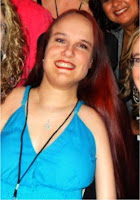>Every person in the world carries a burden that makes them extraordinary.
This is not about attention. This is about raising awareness.
Thursday is Arthrogryposis Awareness Day, a day that was begun by AMCsupport.org – a nonprofit organization designed to educate, raise funding for families of children with Arthrogryposis, and draw attention to a condition that has not yet been researched enough by the medical community to find a cure. People are being encouraged to WEAR BLUE THURSDAY to show their support for raising awareness for this condition and also to educate themselves. I’m doing my part today by teaching you about my disability.
I had intended to find pictures of Arthrogryposis for examples but searching Google Images showed me sights of fetuses and babies with the condition who did not survive. I couldn’t take that sight. Instead, I’m showing you a couple of pictures of me in which you can see my deformities. This was not easy for me to do because I typically hide it in photography but people need to see what it really looks like. Here it is.
The full, obnoxious medical name of this condition is Arthrogryposis Multiplex Congenita or AMC for short. Let’s break that down. Arthrogryposis means hooked or curved joints, in so many words; and Multiplex means the condition is found in multiple limbs; and Congenita means from birth, as in this is a condition that is present in children beginning during gestation. In other words, this is a condition of curved or hooked (deformed) joints in multiple parts of the body from birth. That’s the most simple explanation I can give but this condition is so complicated and difficult understand let alone diagnose that most general practitioners have never seen it. I know this because I have only had one general practitioner in my entire life (my present doctor) who didn’t have to Google the word Arthrogryposis as soon as I gave him my patient history. Usually doctors will smile and nod when I tell them what my diagnosis is and that they quietly excuse themselves to go and get on Google like everybody else does. When a doctor has to do that, you know it’s not a very common condition. I actually had a hospital in Texas refuse to admit me to the ER once because they didn’t recognize my disability and they didn’t want to be liable if they treated me wrong.
Basically, what has happens to a person with Arthrogryposis is that during their gestational period, while their joints were forming, something went wrong and their joints became overgrown with fibrous tissue to the point of severely restricting mobility and causing deformities. If the fetus cannot move adequately, muscle tissue does not develop properly, nerve tissue does not develop properly, bones do not develop properly, and so on and so forth. The lack of mobility in joints affects so much more than just the ability to move. Added to the overgrowth of fibrous tissue on joints, the fetus cannot properly bend over in the womb (the fetal position) and that causes scoliosis – a severe curvature of the spine – as well as deformed hip joints and deformed arms and legs.
When I was born, my legs were crossed as if sitting Indian style on the floor. Go sit on the floor Indian style and look at your legs right now. That’s how my legs were permanently positioned in the womb and I could not turn around to come out head first, so I tried to come out knees first. Naturally, my mother had a cesarean section because of the severity of my disability. As soon as I was born, I was taken away to a completely separate hospital equipped to deal with special needs babies and my mother didn’t see me for several days. They didn’t know what to do with me so they put me in with the preemie babies and the nurses started calling me a monster because I was so much bigger than the other babies for whom they cared. Doctors from all over the city came to examine me because they had never seen such a severe case of Arthrogryposis. An immediate study of my genealogy was done to see if anyone else in my bloodlines had the condition but the study was incomplete due to huge gaps in my family history. Pictures were taken of me to put in medical textbooks and my mother had to go and speak to a gallery of doctors about the conditions of her pregnancy, our family history, and so on and so forth.
Arthrogryposis is found in approximately one in 3000 live births in this country. It covers about 400 different clusters of symptoms, meaning there are several symptoms associated with it but they can be found in about 400 different combinations. It can range from anywhere between just having deformed hands all the way up to complete quadriplegia with lockjaw and developmental disabilities. The symptoms associated with Arthrogryposis can include but are not limited to hip/shoulder dysplasia (this is when your hip/shoulder joint does not form properly and you are not making the ball and socket connection because either the ball or the socket are not there or so severely deformed that they can’t form a hip/shoulder joint), scoliosis, arthritis, osteoporosis, clubfeet, severely shortened tendons and ligaments (this is a main cause of deformed hands, knees and feet when the shortened connective tissue pulls those limbs downward), depressed lung function, heart disease, and a myriad of other symptoms.
Roughly 30% of children born with Arthrogryposis do not live to see adulthood.
There is no curative treatment for this condition, although parameters have been defined in the last 20 years or so by doctors who actually have an interest in making life more bearable for their patients. I was born about 10 years before these parameters were defined enough to make a difference, so I was more of a guinea pig for my doctors than anything else. I spent the first couple of years of my life in Denver, Colorado, and there was a time when I had to fly once a month to Salt Lake City, Utah, because that was the only children’s hospital in the area equipped to deal with my disability. It is extremely important to treat Arthrogryposis as best as doctors can before the child reaches puberty because the body has not finished developing and it’s easier to loosen up all the tight limbs. I had most of my surgeries before age 12 – by “most” I mean I’ve had somewhere between 17 and 20 surgeries (I lost count) in my 29-year lifetime. It’s not uncommon at all for someone born with this condition. They have to treat each limb at a time. First I had surgery to cut the tendon in my neck because it was too short and I could not pull my head up straight as an infant, then I had clubfoot surgery, then I had surgery to break my thighs and turn my legs into a correct position for sitting rather than the Indian style position, then I have hardware put in my hips to try and stabilize my joints, then the hardware was taken out because it was painful and making me bleed, and then I had my entire spine fused with titanium rods from neck to tailbone, and so on and so forth. Doctors have tried to get me to have surgery on my hands over the years to straighten them out (think of Capt. Hook) but it’s not going to do any good. It would only be for cosmetic reasons and I’m not interested in trying to look “normal” if I’m not going to gain any function out of it. I’m still looking at more surgery on my feet and I’ll be 30 next year. It never ends.
Most children born these days with Arthrogryposis have a good chance to at least have enough successful medical treatment to use a walker or crutches instead of being completely dependent on a wheelchair like I am. My time has passed. My body is finished developing and the treatments that they are using for children now are not going to be as successful for me so I will remain completely dependent on wheelchairs. I will never walk. I will never stand on my own. I consider myself blessed, however, because I do have full and complete sensation in my body, meaning I can feel everything done to me – both pain and pleasure. There seems to be a misconception that all quadriplegics can’t feel anything, which is completely not true. I do not have a spinal cord injury. That is what determines whether you physically feel things or not.
The human body has an amazing ability to adapt. I have seen many people with Arthrogryposis teach themselves to be independent at very young ages by using their feet or their mouths in place of their hands when the hands are too deformed to function. People seem to think it’s strange or unheard of that I do everything with my mouth – drawing, typing, writing, and everything else – but it’s quite common amongst those with Arthrogryposis. We were never taught to adapt that way. It happened by instinct out of necessity when we were babies or toddlers. I was once even told about an artist colony in Italy specifically set up for artists who use their mouths or free instead of their hands. We are out there. We are products of nature’s wonderful ability to adapt for survival.
Life can be expensive for us though and without Medicaid, we would all suffer a great deal. Power wheelchairs start at $15,000. I had one that was $35,000 once. Adaptive equipment like braces, eating utensils, writing utensils, lap trays, ramps, shower chair, toilet chairs, and so on, run into hundreds of thousands of dollars. I remember seeing a bill for my shower chair once and it was $4,000. Most things are provided to us by Medicaid but transportation is another issue. People are always stunned to find out that I don’t have a wheelchair van and I cram my wheelchair into a Dodge Neon. First you have to buy the van. Then you have to take it to a specialized shop and drop about $50,000-$100,000 on lowering the floor, installing special shocks, special tires, and either the ramp that pulls out from the floor to the street or the hydraulic wheelchair lift. That’s why I don’t have a van. Additionally, a person with Arthrogryposis can run up medical bills running in the millions of dollars over their lifetime if they go through as many surgeries as I have.
For children born with Arthrogryposis, the chronology of our lives were marked by which surgery was happening when and which hospitals we were calling home at any given time. A lot of people like to say to us, “You are so special. I don’t know how you live the way you do.” I noticed that most of us as we reached adulthood had a difficult time accepting praise of that nature without feeling like it was undeserved because we simply don’t see ourselves in those terms. We just don’t know any better, the same as people who were born with the ability to walk don’t know any better. I can’t even wrap my brain around what the ability to walk would be like any more than anyone else could wrap their brains around what it would be like to be restrained to a wheelchair day in and day out. It’s all a matter of perspective. What is normal to one person is terrifying to another person. I’m well-aware that my life might not be as long as other people. I have been warned since childhood that chances of heart disease are much higher for me than others because I have Arthrogryposis and I have to start watching my heart better at 30. I’m 29 now. My kidneys struggle as well, which is something else they tell me can get out of control if I’m not careful. Regardless if I die tomorrow or when I’m 100, nobody else knows how long they will live and I’m not worried about it. I’m already doing better than the 30% of children with Arthrogryposis who do not live to see adulthood.
I have been told that I shouldn’t do Civil War reenacting, or I travel so much, because I have Arthrogryposis. Even a man I casually know once said, “Did you really come here by yourself?” and when I said yes, he said, “Wow, that’s crazy….” as if he couldn’t believe I could go anywhere by myself. (Hi Jon. I’m calling you out. Love you.) People who say those things catch me off guard even when it’s lighthearted joking because I don’t think in those terms at all. What’s crazy to me is shutting myself up in my house and living life from my bed and my laptop like an invalid. People who see me doing something totally normal in my world like signing my name with a pen in my mouth and then becoming utterly astounded by it confuse me sometimes too. What I mean to say is I don’t see myself as disabled or amazing until someone points it out to me and then I’m sort of taken aback, like, “Oh yeah…. There is a disability in me and not every quadriplegic has the gumption to go whitewater rafting, horseback riding, swimming, traveling, etc., etc., like I do.” I was not raised like a disabled girl. I was raised like a girl who needs to find different ways to live because life is short and cannot be wasted on self-pity or fear of leaving the house. I have seen disabled children raised completely coddled and overprotected by their parents because it’s a parental instinct to care for a helpless child but my parents let me find my own way in life. I have pictures of camping with my father as a toddler. I have other pictures of bass fishing with my mother. If I want to do something, I think about it until I come up with a way to make it happen. If I ever have children, they will be raised that way too.
My only wish is that more children don’t have to be born with Arthrogryposis. I’ve had a good life but I’ve had a very hard life too and I’ve wanted to give up many times. I can’t imagine there will ever be a cure but we won’t ever know unless we try. A few doctors in New York and California are known to study it but I’m not aware of any other serious research. The problem is that American society is obsessed with celebrity and without a celebrity face saying, “I have Arthrogryposis,” there won’t be that push to research, improve treatments, and one day maybe find a cure. My blog only throws a pebble into the water but it’s something. If enough people throw enough pebbles into the water, a real difference could be made. Even if we never find a cure to prevent it from happening to other children, more education needs to happen in order for more effective surgeries, therapies, and so forth. The goal needs to be giving children the most mobility and protection from pain as possible. One thing doctors didn’t prepare me for – maybe because they didn’t know – is the rapid aging my body has gone through since I was 25 and how much pain I live with as I age. I’m only 29 but my body has osteoarthritis, anemia, chronic vertigo, etc., as if I am approaching my elderly years. This may not be common for less severe cases of Arthrogryposis but I’m shocked at how fast I feel like I’m aging. I feel like younger generations with this condition need to be better prepared for the long haul.
How can you help? Donate your time and resources to children’s hospitals. The majority of our childhoods were spent in those places. Also, make donations to Arthrogryposis Multiplex Congenita Support, Inc., at www.amcsupport.org and help take care of families with Arthrogryposis children in need of medical equipment and medical treatments. Encourage and support people of all disabilities. Above all, educate yourselves and encourage the medical professionals to educate themselves about Arthrogryposis as well.
And WEAR BLUE ON THURSDAY. Show your support!
Thank you.
Read More
































